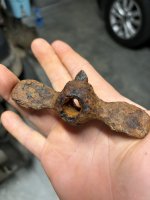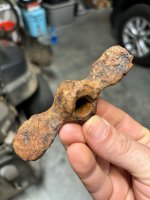Nathan W
Bronze Member
- Jan 14, 2023
- 1,745
- 4,328
I been searching for valves and knobs and taps, I can't find anything that resembles this that's iron. I'm sure it's probably obvious and I'm overthinking it. The little sharp tip is curious, it doesn't appear to be broken off I don't think. I'm trying to clean it up further. Found at 1890s mill site. Maybe a forged wing nut?







